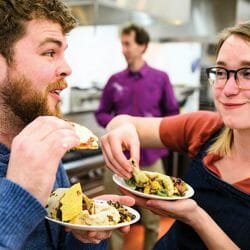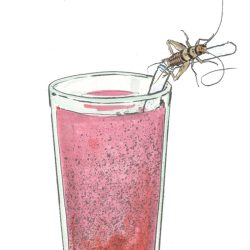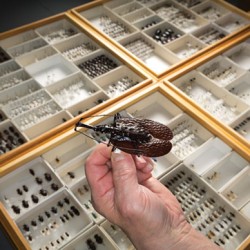Eew or Yum?
A pioneering UW entomologist helped start the insects-as-food movement.
In 1974, the late Gene DeFoliart had a brainstorm — using insects as food — that he knew would be a tough sell. But the UW professor of entomology saw inescapable logic: people need protein, which insects produce with few of the costs and environmental drawbacks linked to conventional livestock.
As a child, DeFoliart had been fascinated by butterflies, and after arriving at the UW in 1958, he made his scientific reputation exploring how mosquitoes were spreading the La Crosse encephalitis epidemic through the Midwest.
By 1988, when he started Food Insects Newsletter, DeFoliart was obsessed with the idea of cooking and “plating” insects. “The more I thought about the possible implications of insects as a food resource, the more fascinated I became,” he wrote.
No matter how repulsive the idea was to many in the developed world, it turned out to be quite common elsewhere. A 2013 United Nations report estimated that two billion people, mainly in less-developed nations, eat 1,900 species of insects, including locusts, caterpillars, mealworms, termites, and ants.
In recognition for his formative role in investigating and promoting “entomophagy,” the UN report was dedicated to DeFoliart.
The very idea of eating animals that most entomologists were trying to kill was heresy to some in the profession, but DeFoliart’s determined advocacy and investigation helped launch a small-scale scientific quest. “The area of food insects took off with him,” says Florence Vaccarello Dunkel ’64, MS’66, PhD’99, a fellow proponent who is associate professor of entomology at Montana State University. “He connected people, professors, and the public with chefs and people who were meeting the public at museums and zoos.”
DeFoliart held sampling sessions at Russell Laboratories, where favorite dishes included mealworms in sour cream dip and crickets roasted in butter and garlic. Looking for data, he and his wife, Lou (Louise) Ball DeFoliart ’76, drove some students to Colorado, retrieved bushels of Mormon crickets, and returned to Madison to measure the protein content. The crickets, they learned, were comparable to more familiar meats.
DeFoliart died in January 2013, just before the release of the UN report that added so much credibility to his belief that insects are a benign source of protein on a shrinking planet with a soaring population.
“He wanted to make sure that third-world countries did not discount what they were already doing, just because we told them they should eat beef,” says his daughter, Linda DeFoliart ’81. “He was not so concerned about Americans. He felt this was more important for others.”
Published in the Summer 2013 issue




Comments
Dennis Merrritt, BS entomology '66, MS '67 March 4, 2014
Gene DeFoliart was an excellent scientist and an even finer human being,so much so that he was one of the people I dedicated my book to, Land, Weather, Seasons, Insects: An Archetypal View.
RNA, Little Herds March 7, 2014
Thanks for the great read about Gene DeFoliart. I regret that he passed right as Little Herds was starting; we would have enjoyed meeting him and hearing about his vision. We’re hoping to carry the torch he lit as we go forward, and become an organization he would have been proud of.